Nov 27, 2014 | celebration, coins, commemorative
1920 Pilgrim Tercentenary Half Dollar Commemorative
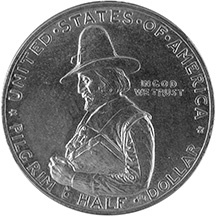
This coin commemorates the 300th anniversary of the landing of the Mayflower. The image is of a pilgrim carrying a Bible.
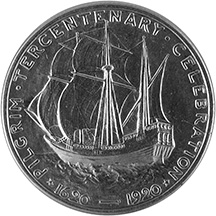
The image is of the Mayflower, the ship that brought the pilgrims to Massachusetts.
Thanksgiving in the United States is usually traced back to the Pilgrims celebration of their first successful harvest in 1621. The three-day event was attended by 53 Pilgrims and 90 Native Americans that lasted three days. The tradition of giving thanks for successes was a tradition that the Pilgrims brought with them from England. This three-day celebration in 1621 is considered the first Thanksgiving.
Although there is no record of the menu, it is likely that the meal consisted of food from the harvest, venison, and Indian corn. The local natives killed five deer as gifts for the celebration. Given the abundance of seafood nearby, it is likely some made it to the celebration as well.
Thanksgiving was celebrated during many different times within the colonies, mainly to give thanks for something that was honorable to the colony or the locality that observed the celebration. The first national recognition of a Thanksgiving celebration came when General George Washington declared December 1777 as Thanksgiving honoring the defeat of the British at Saratoga. As President, George Washington declared the first national Thanksgiving celebration on November 26, 1789. The only other president to issue a Thanksgiving proclamation was President James Madison. From then, it was up to the individual states to declare a Thanksgiving holiday.
After reading a diary from the time of the Pilgrims, writer and editor Sarah Josepha Hale wrote editorials campaigning to bring back the Thanksgiving celebration. As part of her efforts Hale developed recipes for roasted turkey, pumpkin pie, and stuffing that are part of the inspiration for today’s Thanksgiving feast.
Hale’s message made it to the White House where it was embraced by President Abraham Lincoln. As part of his attempt to maintain the union, President Lincoln issued a proclamation that made Thanksgiving Day a national annual event on the last Thursday in November beginning in 1863.
You might not have heard of Hale but you might know one of her most famous poems. In 1830, Hale published Poems for our Children that included one originally titled “Mary’s Lamb.” Today, it is more commonly known as “Mary Had a Little Lamb.”
Thanksgiving remained the last Thursday of November until 1939 when he declared Thanksgiving to be on the fourth Thursday of the month to give merchants more time to sell good during the Christmas shopping season. Congress passed a joint resolution in 1942 fixing Thanksgiving to the fourth Thursday of November.
In 1947, the National Turkey Federation has provided the President of the United State with one live turkey and two dressed turkeys. President Harry Truman is credited with pardoning the first turkey in 1947 but it did not become a tradition until President Ronald Reagan started in 1987 and continued by President George H.W. Bush in 1989. Since 1989, the pardoned turkeys have lived the rest of their lives at Frying Pan Park in Herndon, Virginia.
Happy Thanksgiving!
Nov 18, 2014 | advice, auction, cents, coins
 Over the weekend I attended an estate auction that included coins for sale. While my new business venture concentrates on all vintage collectibles, I am still a collector and continue to look for those interesting items and the good coins to add to my collection. As I was looking over the lots I noticed one had several blue folders of Lincoln cents. The collector in me could not resist and I picked up the folders and started looking.
Over the weekend I attended an estate auction that included coins for sale. While my new business venture concentrates on all vintage collectibles, I am still a collector and continue to look for those interesting items and the good coins to add to my collection. As I was looking over the lots I noticed one had several blue folders of Lincoln cents. The collector in me could not resist and I picked up the folders and started looking.
Every hold was filled.
What drew my eye first was the hole marked “1909-S VDB.” Even though the 1914-D may be worth more, the 1909-S VDB is considered the Holy Grail amongst change hunters. With only 484,000 struck the odds of finding one are not in a change hunter’s favor. But we keep looking and hoping.
After reaching into my pocket for my ever present loupe, I asked the attendant if I could remove the coin to see the reverse. I had to check for those three letters on the back because it did say it was a 1909-S on the front. With the attendant watching me, I removed the coin from the slot, turned it over and brought it up to my loupe.
Using a 16X loupe I zeroed in on the area where I could find the “V.D.B” only to find something unexpected. On this coin, the “VDB” with no periods were punched into the coin. Holding the coin and turning it in the light to see how the light reacts, it was easy to see that the coin was not real.
Being very disappointed I quietly told the attendant that the coin was altered. She did not know what to do. When I suggested she tell her boss, she took the coin from me and went into a back room. A moment later, she returned and asked me to follow her to the office.
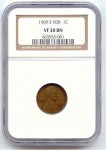
Scott’s 1909-S VDB
I understand how he felt. In the auction business, they earn money from the buyer and seller fees. If the item sells for a high price, the auction house makes more money. In this case, since the coin was a solid VF, it could have sold for $700-800 alone.
Before he became too angry, I asked to see the 1914-D. At VF that coin is about $400 in the retail market. When I looked carefully I could see that the mintmark was added to the coin. It was not a very good job when you see it under magnification but looked all right on first glance. I showed the auctioneer how I know it had the mintmark added. He agreed with my assessment.
He asked if there were any more important dates that he should know about. I zeroed in on the hole for the 1922-D that had “No D” written in pen under the date. Even before finding the date under the loupe I could tell the coin was whizzed. That is a bad sign to begin with but if the coin was real, it would diminish its value but not make it worthless. What made it worthless was that you can tell someone filed the mintmark off the coin. Whoever did the filing did not do a good job because it made a little hole where the mintmark should be. This coin doctor probably whizzed the coin in order to cover up the alterations.
To say I gave this gentleman a shock would be an understatement. He shook my hand and offered me a discount on the buyer’s fee for helping him. After leaving his office he had the attendant who helped me remove all of the blue binders from the auction. When I spoke with the attendant later, she said they were all from the same consignor and that he was going to return them as being unsalable.
This was not the first time I attended an auction at this place and it will not be my last. Aside from being able to purchase good inventory for my business, they have proven to me they have integrity. Knowing this helps me buy with confidence.
I tell this story to provide two lessons. First, always examine the items before you bid. Even for online auctions, examine the pictures and read any descriptions carefully. If you are afraid to buy ungraded coins, then buy only graded coins. But make sure you are fully aware of what is being sold. Do not be afraid of asking the seller a question or even asking for a better picture. If the seller cannot help you then do not buy from that seller.

Buy the book before buying the coin!
My second lesson is to know who you are buying from. This is more difficult online but you do have to take the feedback seriously. Again, if you have any questions you should ask. Every site has a way to contact the seller in order for you to ask questions. If the seller is not cooperative, let that be a sign for you.
When working with auction houses, it takes a little longer to establish a relationship. But you need to introduce yourself, talk with people and ask questions. Make yourself known and show that you are a serious buyer. It may take a few auctions to establish a relationship, but be persistent. Aside from preferential treatment and discounted seller fees, someone with a relationship can be told bout unpublished items in advance so that you are prepared to buy quicker than someone off the street. Another advantage is that if you specialize in something that the auction house cannot sell, you can buy it as a good price. As a reseller, I find that very good for business.
Even though online auctions are very popular, there is nothing better than being there live. I highly recommend the experience.
Nov 13, 2014 | coins
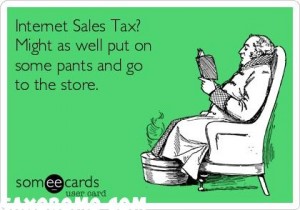 Although the numismatics industry generates millions of dollars per year, it is dominated by small businesses. You can see this by going to any show and with the exception of the major auction and bullion companies, the vast majority of the dealers you see on the bourse floor are small businesses. Numismatics may be one of the few national industries that you can meet the owner just by walking up to their table at a show.
Although the numismatics industry generates millions of dollars per year, it is dominated by small businesses. You can see this by going to any show and with the exception of the major auction and bullion companies, the vast majority of the dealers you see on the bourse floor are small businesses. Numismatics may be one of the few national industries that you can meet the owner just by walking up to their table at a show.
Numismatics is not alone as being dominated by small businesses but it is the only industry that generates notice because of the prices for its high end merchandise. Face it, some people cannot comprehend how someone can pay over $10 million for a one dollar coin. Forget the fact that the coin may be amongst the first dollars produced by the U.S. Mint, it is still just a one dollar coin.
We keep hearing that small businesses are the backbone of the economy and that Main Street does not function without small businesses. Small businesses have been using the modern equivalence of mail order in order to expand beyond Main Street to reach customers where ever they are. In the spirit of Aaron Montgomery Ward and Richard Warren Sears whose mail order catalog businesses are the legends of business history, modern entrepreneurs have been leveraged the Internet to sell goods and services to a worldwide public.
Even though the small business is the backbone of the economy, their existence is constantly under attack. Aside from over regulation and complicated tax requirements, states want these small businesses to now collect sales taxes from the customers in the states that require sales taxes. This is not limited to sales by catalogs and the telephone. Sales made using the Internet would be subject to the customer’s sales tax.
In other words, as a small business owner in Maryland but I sell a coin to someone in Virginia I would have to collect the sales tax for the Commonwealth of Virginia. The same would be true if I sell a coin to someone in the District of Columbia or the State of New Jersey. However, if I sell the same coin to someone in Delaware I would not have to collect sales taxes since it is not required by Delaware.
This also does not count the states that collect sales taxes for the sale of coins but not the sale of bullion or for coins over a certain threshold. A small business now has to add additional resources to comply with the laws of all 50 states even though they are present in only one.
The Senate passed the Marketplace Fairness Act (S. 734) with objection from the senators representing states that do not have sales tax laws. In the House, Judiciary Committee Chairman Bob Goodlatte (R-VA) has been a vocal critic of the bill. Goodlatte has said that the bill is written too broadly and could damage online commerce.
Although the bill was called the Internet sales tax bill, the bill was written in such a way to require all interstate sales to be subject to the collection of sales taxes. Collecting of sales tax would include everything from services to advice as well as digital downloads including music, smartphone apps, and streaming music services.
On Monday, all small businesses breathed a sigh of relief when a spokesman for Speaker of the House John Boehner (R-OH) said:
The speaker has made clear in the past he has significant concerns about the bill, and it won’t move forward this year. The Judiciary Committee continues to examine the measure and the broader issue. In the meantime, the House and Senate should work together to extend the moratorium on internet taxation without further delay.
This does not mean the Senate has given up. Sen. Mike Enzi (R-WY) has attached the wording of the Marketplace Fairness Act to a bill that passed the House to extend a moratorium on taxing Internet access. Although this has some support from Sen. Orin Hatch (R-UT), ranking member on the Senate Finance Committee, Chairman Ron Wyden (D-OR) is against the bill since Oregon is one of the states that does not have sales tax laws.
With the Democrats facing the loss of control of the Senate in January, it may be unlikely that the Democratic chairman of a committee would give a Republican something he wants during a lame duck session. Wyden will block the measure and work with Majority Leader Harry Reid (D-NV) to promote their agenda before they lose control.
But for now, you can order coins from your favorite out of state dealer or even from your favorite auction website without having to worry about having to add sales tax to your purchase.
Nov 6, 2014 | bullion, coins, commentary, gold, US Mint
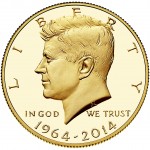 Every Thursday morning, the U.S. Mint looks at the afternoon London Fix price of gold and adjust their bullion-related coins based on their published tables. This morning, the U.S. Mint adjusted prices after noting that the afternoon London Fix priced gold at $1,145.00 per troy ounce. Based on the table published in the Federal Register, the price of the 50th Anniversary Kennedy 2014 Half-Dollar Gold Proof Coin was reduced to $1,165.00!
Every Thursday morning, the U.S. Mint looks at the afternoon London Fix price of gold and adjust their bullion-related coins based on their published tables. This morning, the U.S. Mint adjusted prices after noting that the afternoon London Fix priced gold at $1,145.00 per troy ounce. Based on the table published in the Federal Register, the price of the 50th Anniversary Kennedy 2014 Half-Dollar Gold Proof Coin was reduced to $1,165.00!
Please pardon me as I laugh at all of those dealers whose questionable ethics caused despicable scenes in Philadelphia, Washington, Denver, and Rosemont at the ANA World’s Fair of Money when the introduction price was $1,240. Those who have waited to order the coin directly from the U.S. Mint for a coin that does not have a mintage limit will have saved $75 from the issue price. And by buying from the U.S. Mint, you do not have to pay the alleged “numismatic premium” dealers will apply for the special label encased on the plastic they paid to have the coin entombed in.
Regardless of what the politicians say, some business pundits recognize that the economy is moving forward and the stronger dollar will continue to push prices lower.
If the price of gold drops below $1,100 by next Wednesday afternoon’s London Gold Fix, the price of the Kennedy gold halves will drop to $1,127.50. If that happens, I will be back to laugh even more!


 Over the weekend I attended an estate auction that included coins for sale. While my new business venture concentrates on all vintage collectibles, I am still a collector and continue to look for those interesting items and the good coins to add to my collection. As I was looking over the lots I noticed one had several blue folders of Lincoln cents. The collector in me could not resist and I picked up the folders and started looking.
Over the weekend I attended an estate auction that included coins for sale. While my new business venture concentrates on all vintage collectibles, I am still a collector and continue to look for those interesting items and the good coins to add to my collection. As I was looking over the lots I noticed one had several blue folders of Lincoln cents. The collector in me could not resist and I picked up the folders and started looking.



